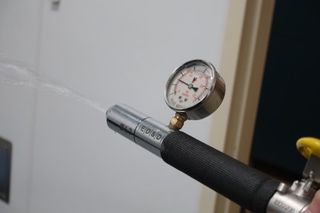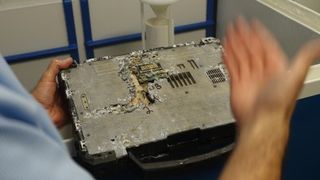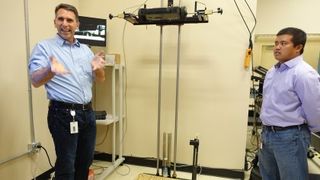How Dell's modern day torture dungeon inspires rugged notebook designs
Dell's tech dungeons without the dragons
Attack of the fire hose
Unlike rival HP's expansive Houston, Texas testing facility, Dell's rugged lab only occupies three small rooms in an office building, which also houses corporate offices and Dell's design studio. The close proximity to the design studio means that if a system fails a rugged test, Dell's rugged team is able to consult with the designers and engineers to understand the failure and quickly re-tool the system so that it passes when retested.

In an isolated room reserved for liquid testing, Moore showed off one of the more visually stunning tests that Dell performs in its rugged labs. After pulling out a fire hose, turning it on to spray three pounds per square inch (PSI) and shooting jets of water at a Latitude 14 Rugged Extreme notebook with a touchscreen, he handed me the hose to test water ingress protection.
Fortunately, the Latitude 14 Rugged Extreme survived testing. I didn't notice any damage to the exterior, and the keyboard and touchscreen were functional after the laptop was powered down and powered back on. Dell's Latitude 14 Rugged Extreme is constructed with compression gaskets to seal the internals from dirt, dust and water. It comes with an IP-65 rating, meaning that no dust should be able to enter the Latitude, and the laptop is protected from water jets with elevated pressure.
In the water lab, Dell also had a saline chamber where laptops are tested for corrosion. This is an important step in the testing process. If the right types of metals are placed in close proximity to each other, and salt is introduced in the environment, then serious corrosion could quickly occur, Moore said.

By using the saline chamber, Dell's rugged team discovered that engineers were using just the right mix of metals for rust and corrosion to destroy a significant portion of a Latitude Rugged's metal undercarriage and frame. The rugged team quickly consulted with design engineers, substituted metals, and disaster was averted due to early test detection.
"After a failure, the unit is examined by the engineering team," a Dell spokesman wrote in an email. "The engineers determine root cause and then determine how to fix it. This solution is then incorporated into the design, tooling is modified if necessary and the improved design is used for the subsequent build. That build is brought into the lab, tested to failure and the cycle starts over again."
Drop it like it's hot (or cold)
Walking out of the wet room and into the main testing room, I was greeted by a an apparatus butting up against a wall that was almost as tall as the ceiling's 15-foot height. The machine, which looks like a scale in a doctor's office, contains markings along the wall, delineating various height measurements, and is anchored on the floor by a large square piece of plywood that is two inches thick and measures about the size of a small area rug.
Are you a pro? Subscribe to our newsletter
Sign up to the TechRadar Pro newsletter to get all the top news, opinion, features and guidance your business needs to succeed!

The machine, as I was informed by Moore, is used to perform drop tests on Dell's notebooks and tablets. Up to 26 drop tests are performed on each system at different height levels, and Dell says it tests the impact on corners and surfaces of its notebooks to ensure they survive drops from all angles.
A Latitude 12 Rugged Extreme laptop was dropped at a set height – up to 8 feet in the test that I witnessed – onto the plywood with the undercarriage side, or base, facing downward. After a loud thump, Moore and I checked the system, which survived the drop and is fully functional. We observed small cosmetic damages – little nicks and scuffs.
Dell says that internally, its test goes even further, testing drops as high as 9 feet or even 12 feet, and some tests are even done with the laptop in an open position. This puts additional stress on the system, and if the notebook survives Dell's labs, it should survive testing using standard specifications.
To the right of the dropping contraption within the same room are two large chambers. Dell is able to control the temperatures in these chambers to replicate severe heat and cold. Moore claims that Dell's Latitude Rugged Extreme notebooks are certified to operate safely in temperature ranges between -20 degrees to 150 degrees Fahrenheit (-29 to 65.56 degrees Celcius).
One fire department went as far as testing the Rugged Extreme in temperatures up to 200 degrees Fahrenheit (93.33 degrees Celcius) without incident, Moore's team told me.
The importance of testing electronics in high temperature extremes is to ensure that components, batteries and hard drives work in even the harshest environments, especially for mission critical tasks for which equipment failure is not an option.

There are also two machines that actively open and close a laptop to test the integrity of the hinge design. Dell's engineers told me that while these tests are demonstrated on Dell's toughest notebooks, similar tests, made to different specifications, are also performed on regular commercial and consumer systems.
"The purpose of the lab is to test items to failure; therefore, 100 percent [of Dell's systems fail on the first try]," Dell said in an email. "Sometimes, we do have components that take so long to precipitate failure that we end up stopping the test before it fails. An example is the hinge cycle tests where the unit will have been on the tester for months and we need to abort the test so the fixture can be used to test other products."
Desert storm
From the seas to torrential rains, from the desert to the tundra, Dell has shown me that its laptops can perform, but what about when they're used in dusty environments like construction sites? I was led to a small adjoining room with a small chamber with a large glass window.
When I peered through the glass, all I saw was white, and I wondered why Moore's team had told me to look through frosted glass. Moore activated a single-blade windshield wiper with a button located on the side of the machine, and it became clear that what appeared to be frosted glass was a result of dust accumulation inside the chambers. Once the dust was swept away from the glass, I was able to glimpse a lone Rugged Extreme notebook inside.

The machine simulated sand, dust and dirt – contaminants that could have a harmful effect on my consumer-grade MacBook Pro that's concealed in my bag – which seem to have no effect on the Latitude Rugged Extreme 14. The laptop appeared to have weathered the storm when it was powered on, and worked as advertised.
Moore said that the room has its own air ducts and ventilation system. Dell's facilities department was concerned that if the chambers leaked, the particles swirling inside the test equipment would have an adverse effect on the building's HVAC system. Given the humid and hot Texas summer weather outside, I could understand concerns about anything that would prevent the climate control system inside from doing its job.
I was then shown two different types of docking connectors that Dell uses on its enterprise-class notebooks. The more traditional connector comes with latches and mechanical moving parts, which would make it ill-suited for extreme conditions. The latches could break and dust and dirt could enter the laptop with moving parts when a notebook is jostled around in a police vehicle or in a tank.
Moore showed me a second dock, which comes with discrete POGO pins – similar to the charging pins on Sony's waterproof Xperia Z3 smartphone. These pins are more resilient in tougher environments as they don't contain latches or mechanical parts that could break, and Dell opted to use POGO pins for the docks employed on its Latitude Rugged Extreme. The notebooks use the POGO pins to dock into car docks and mounts as well as desktop docks.
When all else fails
Even though rugged testing is incorporated at the earliest stages of the design process to create a system that is durable, sometimes there are failures in the field. To help businesses minimize their downtime, Dell offers premium support packages that provides next-day, on-site service to enterprise customers through ProSupport and ProSupport Plus.
These support packages are available for all of Dell's products – from servers to tablets – and are the equivalent of OnStar for computing.
For example, with ProSupport software installed on a notebook, Dell receives continuous feedback about the condition of the battery and the hard drive. In the event these components fail, rather than having a frustrated customer call Dell for support, Dell can automatically create a case number for the incident, have a service tech call or email the customer and ship the parts overnight or send a service tech to repair.
ProSupport Plus takes it a step further for mission critical businesses. Dell's software, through continuous monitoring of the system, can predict if a hard drive will fail within the next thirty days. With predictive analysis, Dell alerts the customers so they can back up their data and save important files. Dell's support would then ship a new hard drive to the customer.
Dell's support is different from what's available on the market today. Rather than wait for a frustrated customer to call in after a problem happens, Jim Roth, Executive Director of Global Support at Dell, says Dell wants to reach out to the customer and provide a fast fix. Customers don't need to lose downtime by shipping their laptops or waiting in line for tech support because Dell offers next-day on-site service.
With thoughtful support and careful design planning, Dell hopes to reduce incidents and failures with some of its toughest notebooks and tablets.
- Read our picks for the best business notebooks
Most Popular

